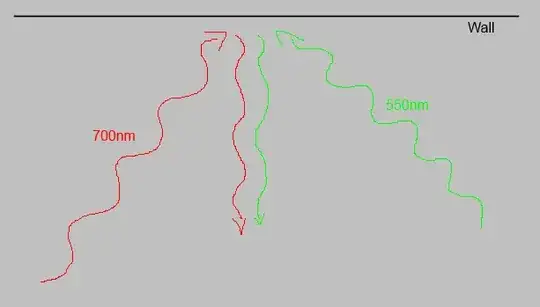My question is, whether this is caused by an modification of the frequency/wavelength or simply by my eye combining the two incoming lights.
Short answer No So your second picture is accurate. Frequency is not modified, the two different waves are added up by your eye to produce the light that you perceive.
Most computer screens operate on a RGB colour model, i.e. they only have red green and blue lights. So the "yellow" light you see coming from your screen contains zero photons of yellow frequency but the exact right proportion of red green and blue to trick your eye into firing neurons the same way it would if photons of the yellow spectrum were striking it.
When "adding" light colours you start with a white wall, that is un-illuminated (black). And then you add red green and blue (the additive primary colours) lights to get any colour you want.
However when "subtracting" colours, if you start with a white sheet of paper illuminated with white light (white) and start adding paints (subtracting colour) you can make any colour by using the tree primary colours red YELLOW and blue (the subtract-ative primary colours), or more accurately as referred to in the printing industry CMYK, cyan magenta yellow and key (black), black is needed because adding enough coloured paint to make an image black is inefficient and expensive.
If you are allowed to add and subtract colours you can mix (almost) any three different colours to generate the illusion of any desired colour. ie you get to choose any three colours as your primary colours. Exactly three colours is required since there are three different types of cones in your eye (three degrees of freedom).
Also note that the sRGB does not encapsulate all different colours, so watching a movie in cinema with a reel film may display hues that cannot be rendered on a computer monitor.
So far I have only dealt with the eye and completely ignored the interaction of the light with the interface. In general light is absorbed, reflected or transmitted through the medium. Reflected light can be coherent light in a mirror or diffuse like a painted wall.
However there are a large number of non-linear optical effects where the photons do interact with each other and may combine.
There are also interactions with the medium such as those seen with a black light.
Links are to the respective Wikipedia pages.

